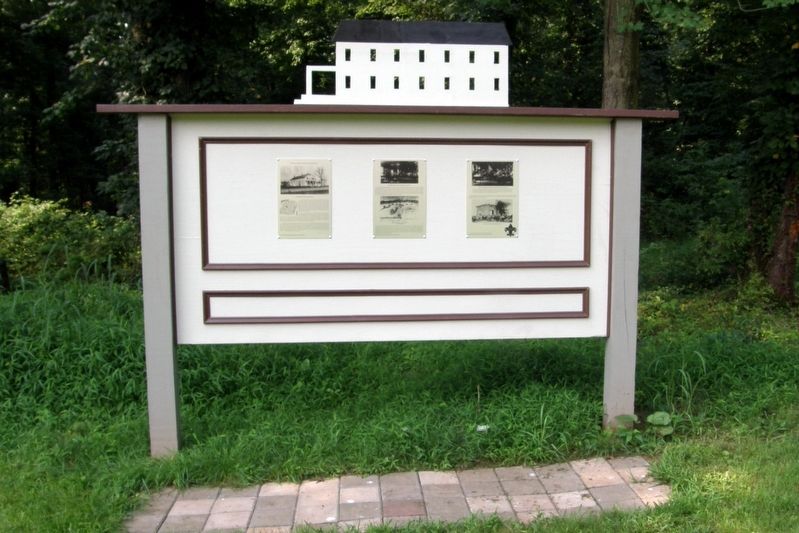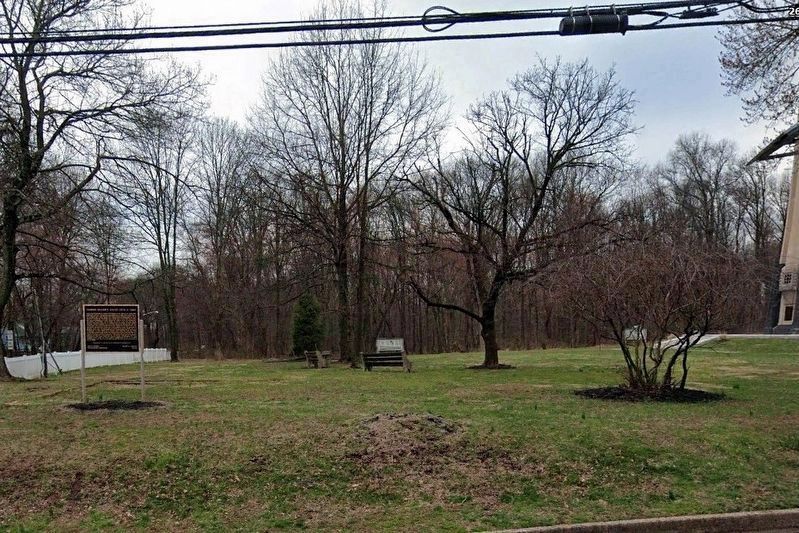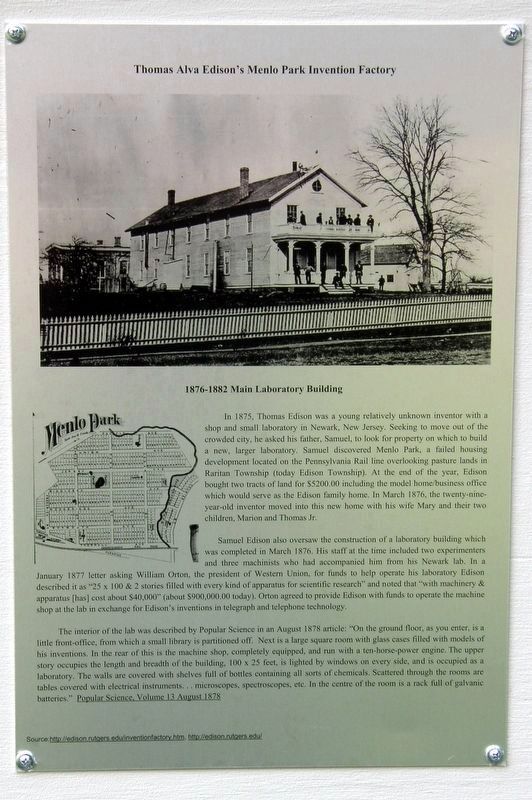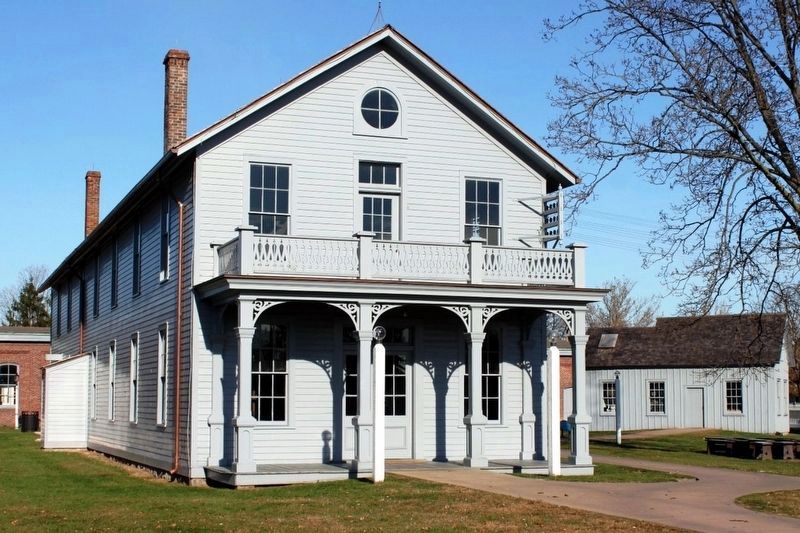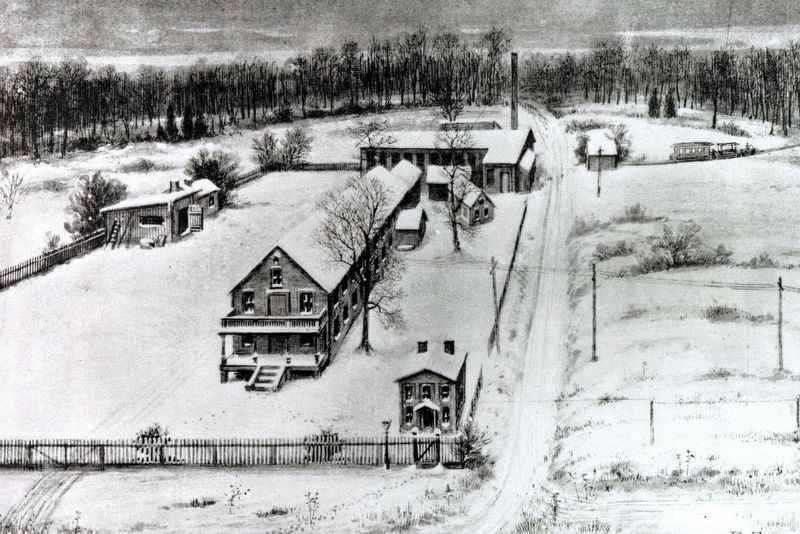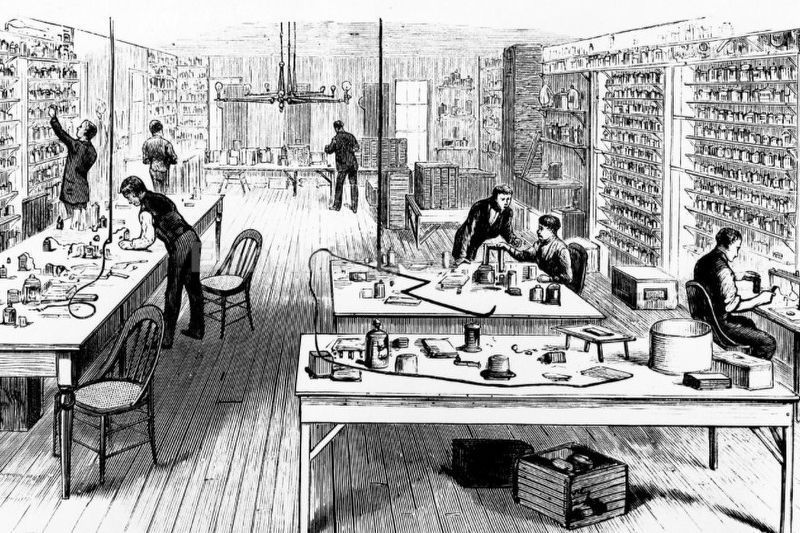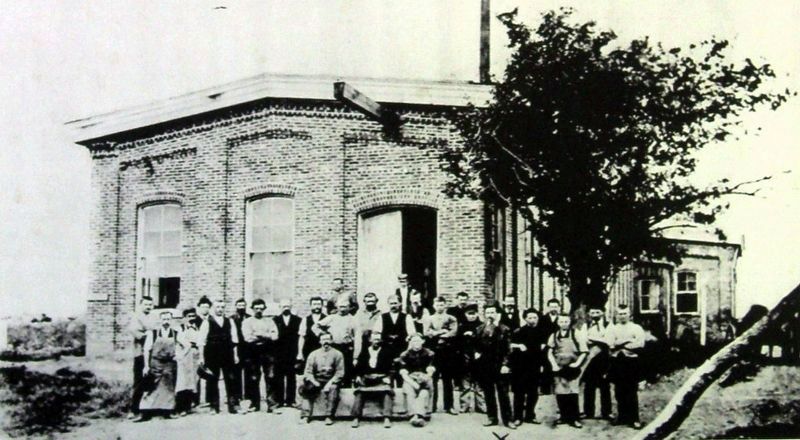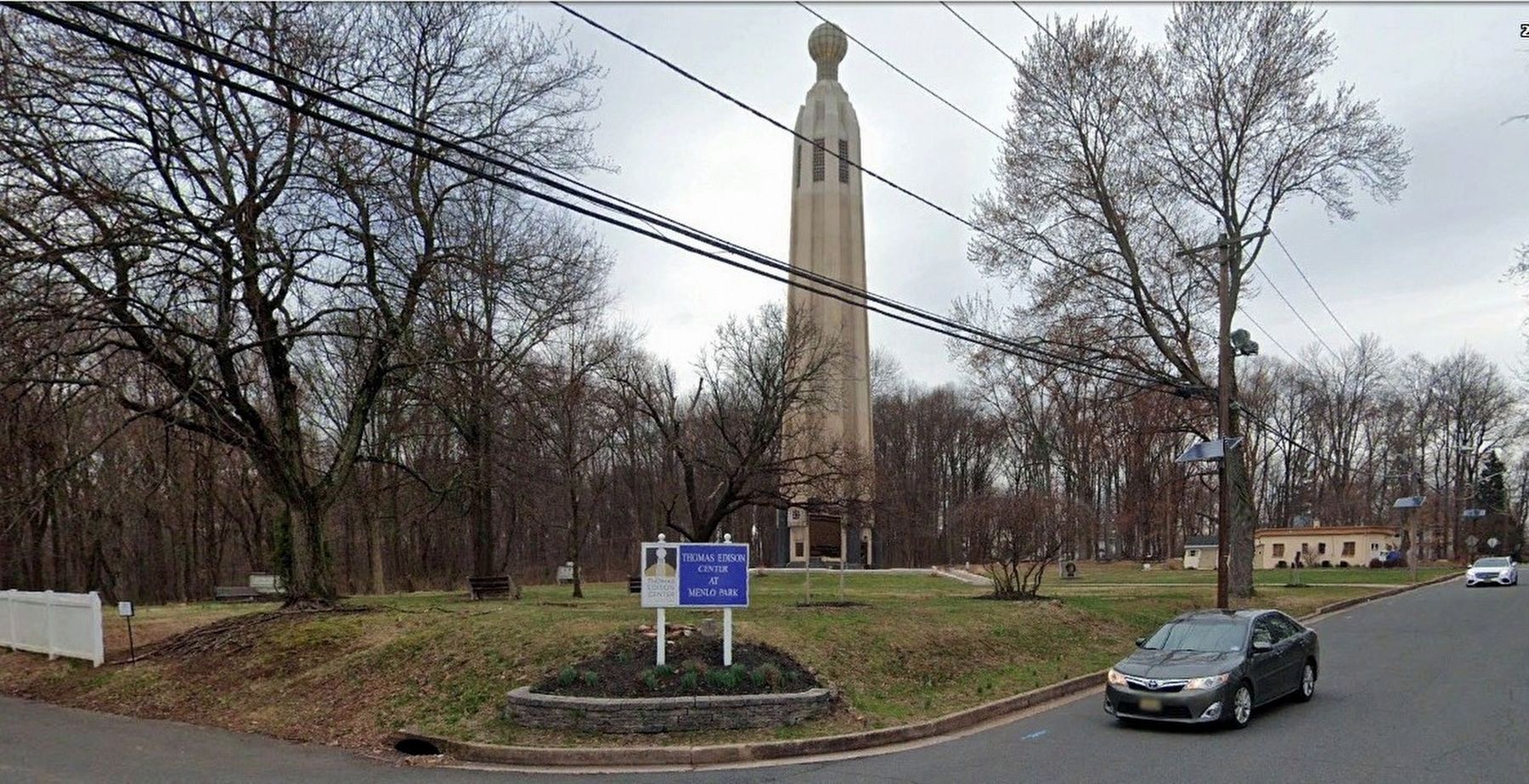Menlo Park in Middlesex County, New Jersey — The American Northeast (Mid-Atlantic)
Thomas Alva Edisonís Menlo Park Invention Factory
Inscription.
Plaque 1:
1876-1882 Main Laboratory Building
In 1875, Thomas Edison was a young relatively unknown inventor with a shop and small laboratory in Newark, New Jersey. Seeking to move out of the crowded city, he asked his father, Samuel, to look for property on which to build a newer, larger laboratory. Samuel discovered Menlo Park, a failed housing development located on the Pennsylvania Rail line overlooking pasture lands in Raritan Township (today Edison Township). At the end of the year, Edison bought two tracts of land for $5200.00 including the model home/business office that would serve as the Edison family home. In March 1876, the twenty-nine-year-old inventor moved into this new home with his wife Mary and their two children, Marion and Thomas, Jr.
Samuel Edison also oversaw the construction of a laboratory building which was completed in March 1876. His staff at the time included two experimenters and three machinists who had accompanied him from his Newark lab. In a January 1887 letter asking William Orton, the president of Western Union, for funds to help operated he laboratory, Edison described it as “25 x 100 & 2 stories filled with every kind of apparatus for scientific research” and noted that “with machinery & apparatus (has) cost about $40,000” (about $900,000.00 today). Orton agreed to provide Edison with funds to operate the machine shop at the lab in exchange for Edisonís inventions in telegraph and telephone technology.
The interior of the lab was described by Popular Science in an August 1878 article: “On the ground floor, as you enter, is a little front-office, from which a small library is partitioned off. next is a large square room with glass cases filled with models of his inventions. In the rear of this is the machine shop, completely equipped, and run with a ten-horse-power engine. The upper story occupies the length and breadth of the building, 25 x 100 feet, is lighted by windows on every side, and is occupied as a laboratory. The walls are covered with shelves full of bottles containing all sorts of chemicals. Scattered through the rooms are tables covered with electrical instrumentsÖmicroscopes, spectroscopes, etc. In the centre of the room is a rack fill of galvanic batteries.” Popular Science, Volume 13 August 1878.
Plaque 2:
1876-1882 Interior Main Laboratory Second Floor
Edison supplemented his funding in 1878 when his invention of the phonograph led to the formation of the Edison Speaking Phonograph Company. As a result Edison increased his staff, hiring about twenty additional employees, including machinists, experimenters, office staff, and a secretary to handle the influx of mail
due to his new-found fame. In late 1878, the Edison Electric Light Co. was founded to fund Edisonís work on lighting technology, and Edison hired more machinists, chemists; (sic) a steam engineer and a lamp blower. He also hired physicist, Francis Upton, the first person to receive a Master of Science degree from Princeton University. Edison also added a new large brick machine shop, a two-story brick office and library, and a boarding house for his employees run by Mary Edisonís step-sister, Sarah Jordan.
By 1880, Edison employed more than (missing?) men at the laboratory. With the dramatic increase of manpower, workspace, and equipment Edison had a significant edge on other inventors. With these resources, Edison could rapidly develop and test prototypes of new inventions and work on different technologies simultaneously. It was these advantages that enabled Edison to invent not just a successful incandescent lamp but develop the electrical system that made it a commercial success. The laboratory complex included the original two-story lab building along with a brick machine shop (rear) and brick office and library building (far right) built with funds from the Edison Electric Light Co. In addition there was a carpenter shop and a building for the glassblower, along with other small buildings.
Plaque 3:
Thomas Edisonís Menlo Park laboratory holds the
distinction as the worldís first organized research laboratory; it would be credited to the development of the modern industrial laboratory. Some would later call this historically important site “The Invention Factory.”
Sean Carlucci
Troop 53
Eagle Scout
Topics. This historical marker is listed in this topic list: Science & Medicine. A significant historical month for this entry is January 1887.
Location. 40° 33.783′ N, 74° 20.358′ W. Marker is in Menlo Park, New Jersey, in Middlesex County. Marker is on Christie Street near Tower Road, on the left when traveling north. Touch for map. Marker is at or near this postal address: 37 Christie St, Edison NJ 08837, United States of America. Touch for directions.
Other nearby markers. At least 8 other markers are within 2 miles of this marker, measured as the crow flies. Thomas Alva Edison Memorial Tower (within shouting distance of this marker); The Invention of the Phonograph (within shouting distance of this marker); Thomas Edisonís Office 1879 to 1884 (within shouting distance of this marker); Thomas Edison and the Electric Railway (about 300 feet away, measured in a direct line); Sarah B. Jordan Boarding House (about 400 feet away); Thomas Alva Edison Menlo Park Memorial (approx. 0.2 miles away); Menlo Park Terrace (approx. one mile away); First Presbyterian Church Of Iselin (approx. 1.1 miles away). Touch for a list and map of all markers in Menlo Park.
Also see . . .
1. Thomas Edison Center at Menlo Park. Museum homepage (Submitted on December 13, 2020, by Larry Gertner of New York, New York.)
2. “Greenfield Village” at The Henry Ford website. Henry Ford reconstructed much of the Menlo Park complex at his Greenfield Village historical site. (Submitted on December 13, 2020, by Larry Gertner of New York, New York.)
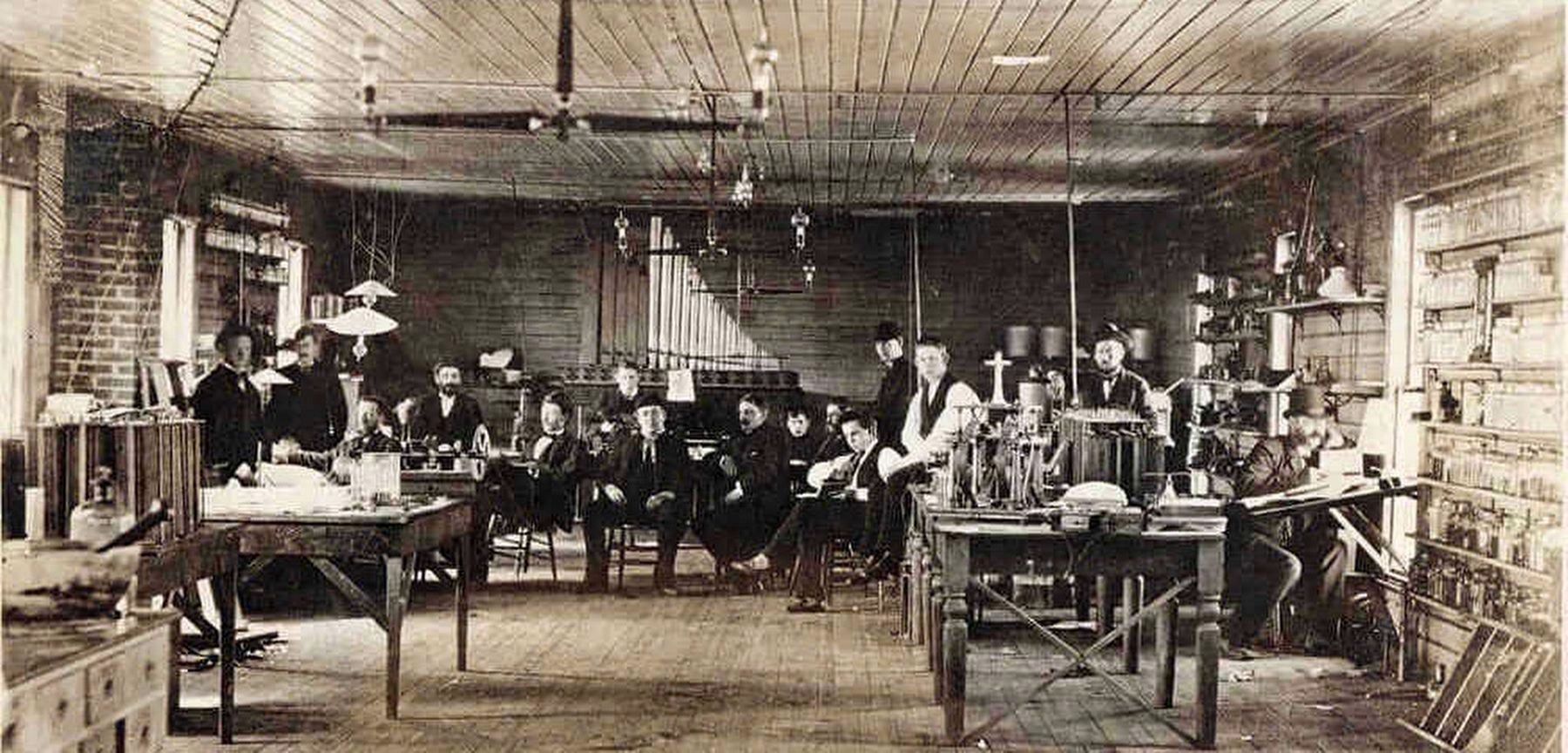
Photographed By Pinterest, 1880
10. February 1880- Edison (seated center) and his Experimental Staff
This picture, dated February 22, 1880, shows the laboratory on the second floor. Left to right: Ludwig Boehm, Charles L. Clarke, Charles Batchelor (seated beneath the hanging lamps), William Carman, Samuel Mott, George Dean, Edison (below the tallest organ pipe , Charles Hughes, George Hill, George Carman, Francis Jehl, John Lawson, Charles Flammer, Charles Mott, and James MacKenzie (at the desk near the window). Notice the incandescent lamps in the gas fixtures. The organ in back was a gift from Hilborne Roosevelt, an early investor in the phonograph.
Credits. This page was last revised on December 15, 2020. It was originally submitted on December 13, 2020, by Larry Gertner of New York, New York. This page has been viewed 679 times since then and 81 times this year. Photos: 1, 2, 3, 4, 5, 6, 7, 8, 9, 10. submitted on December 13, 2020, by Larry Gertner of New York, New York. 11. submitted on December 15, 2020, by Larry Gertner of New York, New York.
